刷爆leetcode第四期
编号0011 分割链表
解法一
给你一个链表的头节点 head 和一个特定值 x ,请你对链表进行分隔,使得所有 小于 x 的节点都出现在 大于或等于 x 的节点之前。
你不需要 保留 每个分区中各节点的初始相对位置。
来源:力扣(LeetCode)
链接:https://leetcode.cn/problems/partition-list-lcci
我们来看图
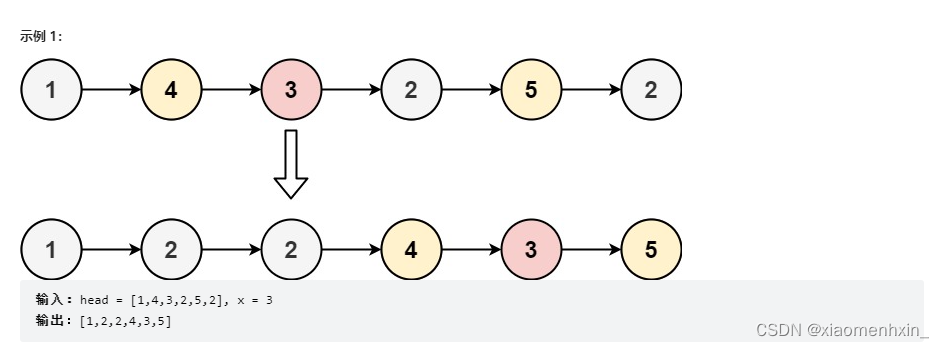
其实这个题目解释起来也简单
我们要将整个数组所有小于x的值放在x的左边
所有大于x的值放在x的右边
解决这个问题我们可以设计两个新链表
然后遍历链表 如果遍历到的元素小于x我们就将它放到创造的第一个链表当中
如果遍历到的元素大于x我们就就将它放到创造的第二个链表当中
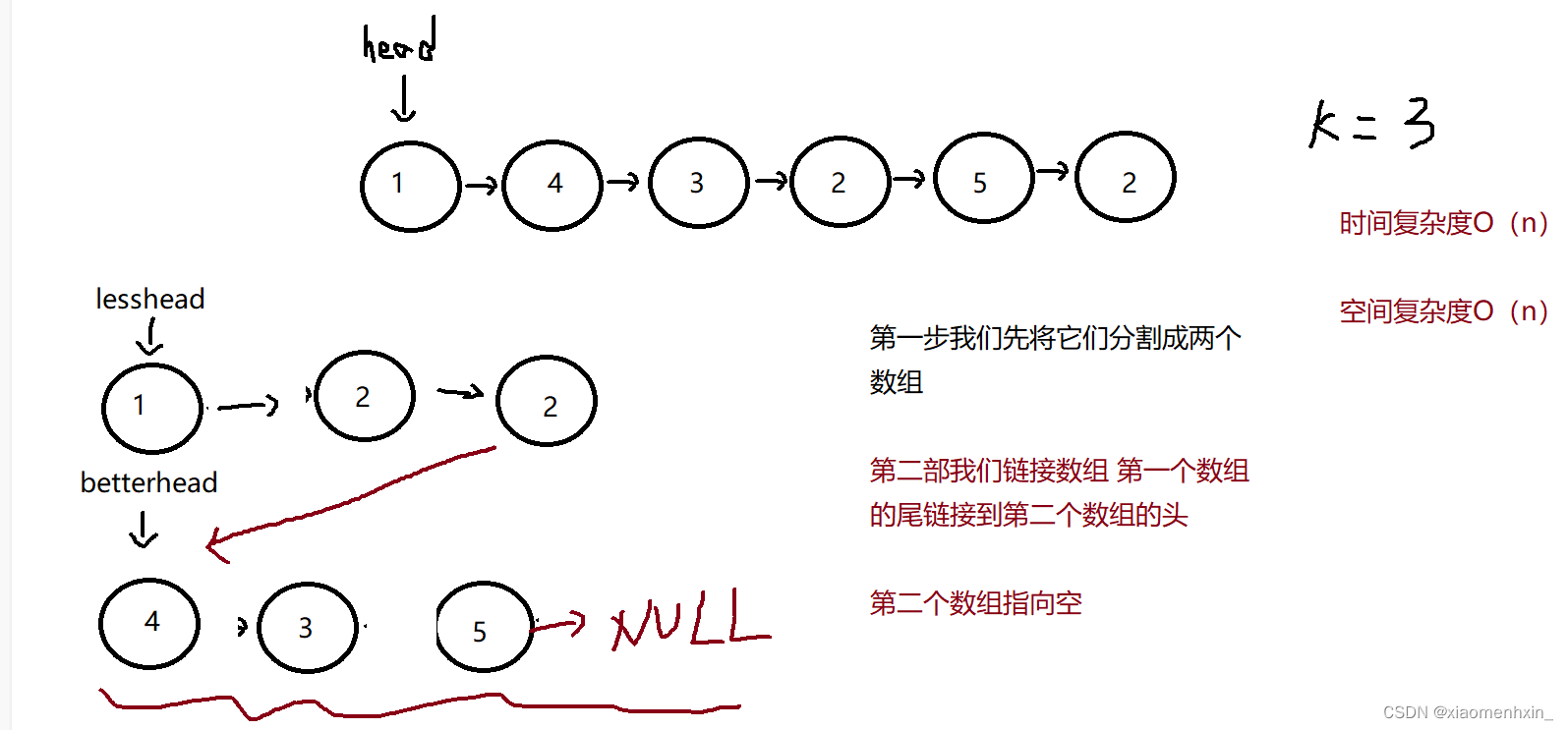
我们这里提交代码

发现最后这里出错了
检查下 发现我们忽略了两种特殊情况
如果都大于或者都小于呢
所以我们补上后面的代码
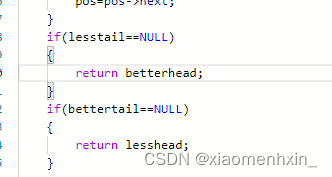
加上后面这段代码之后就能过了
代码完整表示如下
/**
* Definition for singly-linked list.
* struct ListNode {
* int val;
* struct ListNode *next;
* };
*/structListNode*partition(structListNode* head,int x){if(head==NULL){returnNULL;}structListNode* lesshead =NULL;structListNode* betterhead =NULL;structListNode* lesstail =NULL;structListNode* bettertail =NULL;structListNode* pos = head;// pos节点指向空的时候就不进去了 注意结束条件while(pos){if(pos->val<x){if(lesshead==NULL){
lesshead=lesstail=pos;}else{// 尾插数据 注意这里其实lesstail=pos也一样
lesstail->next=pos;
lesstail=lesstail->next;}}else{if(betterhead==NULL){
betterhead=bettertail=pos;}else{//写一种不同的写法 方便大家理解
bettertail->next = pos;
bettertail = pos;}}
pos=pos->next;}if(lesstail==NULL){return betterhead;}if(bettertail==NULL){return lesshead;}
lesstail->next = betterhead;
bettertail->next =NULL;return lesshead;}
解法二
除了上面那一种解法之外我们还可以使用一个新的解法
利用我们学到的基础知识 头插 尾插
如果这个数小于我们规定的值就头插到新链表
如果这个数大于等于我们规定的值就尾插到新链表
画图表示如下

代码表示如下
structListNode*partition(structListNode* head,int x){if(head ==NULL){returnNULL;}structListNode* newhead =NULL;structListNode* newtail =NULL;structListNode* pos = head;structListNode* next = head;while(next){
next = next->next;if(pos->val < x){
pos->next = newhead;
newhead = pos;if(newtail==NULL){
newtail = newhead;}}else{if(newhead ==NULL){
newhead = head;
newtail = head;
newtail->next =NULL;}else{
newtail->next = pos;
pos->next =NULL;
newtail = pos;}}
pos = next;}return newhead;}
这里要注意的是 在既要头插又要尾插的问题中
第一次赋值的时候 一定要把第一个数组的next赋值给空指针
编号0012 回文链表
给你一个单链表的头节点 head ,请你判断该链表是否为回文链表。如果是,返回 true ;否则,返回 false 。
解法一

这里我们有很多种解法
我们先给一种时间复杂度O(N)空间复杂度O(N)的 数组法
还是直接上图
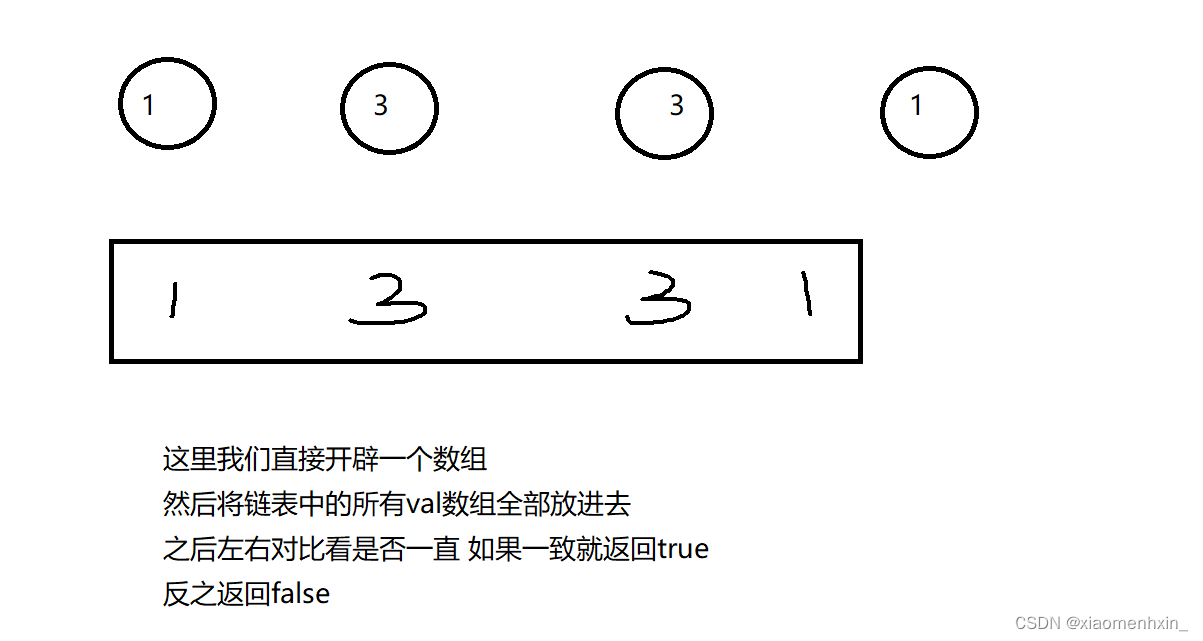
上代码
bool isPalindrome(structListNode* head){if(head==NULL){return true;}int* num_val =(int*)malloc(sizeof(int)*100001);int count =0;structListNode* pos =head;while(pos){
num_val[count++]=pos->val;
pos = pos->next;}int left =0;int right = count-1;while(left<right){if(num_val[left]!=num_val[right]){return false;}
left++;
right--;}return true;}
很简单的解法 也不需要多讲什么了
只有一点要注意的是
空链表是回文链表
解法二
这个解法就比较有难度了
但是它能够将我们的空间复杂度降低至O(1)
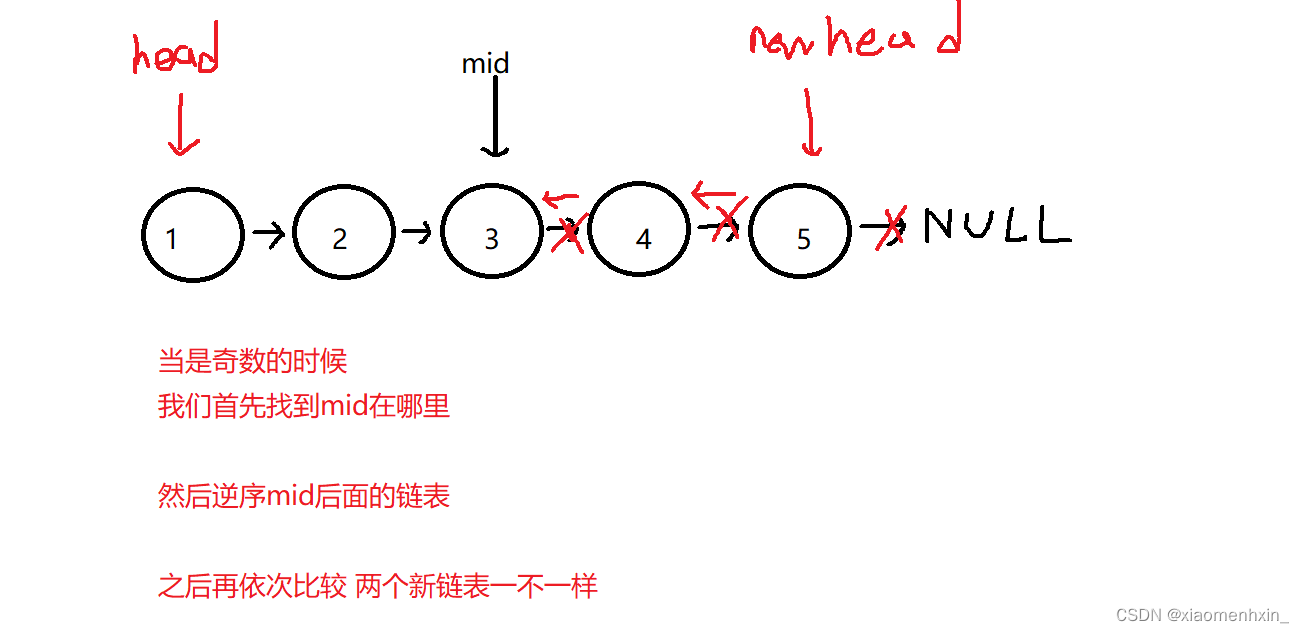
我们首先写两个函数
一个寻找中间节点
一个逆序单链表
代码表示如下
structListNode*Findhalf(structListNode* head){assert(head);structListNode* slow=head;structListNode* fast=head;while((fast!=NULL)&&(fast->next!=NULL)){
slow=slow->next;
fast=fast->next->next;}return slow;}structListNode*reversehalf(structListNode* half){// 这里其实补判断空指针也可以 不过大家尽量养成一个好习惯 if(half ==NULL){returnNULL;}structListNode* prev =NULL;structListNode* pos =half;structListNode* next =half;while(pos){
next=next->next;
pos->next = prev;
prev = pos;
pos =next;}return prev;}
bool isPalindrome(structListNode* head){if(head==NULL){return true;}structListNode* half =NULL;structListNode* halfstart =NULL;// 找到中间节点
half =Findhalf(head);// 翻转中间节点
halfstart =reversehalf(half);// 比较两个链表 structListNode* p1 =head;structListNode* p2 =halfstart;while(p1&&p2){if(p1->val!=p2->val){return false;}
p1=p1->next;
p2=p2->next;}return true;}
编号0013 双链表相交节点
输入两个链表,找出它们的第一个公共节点。
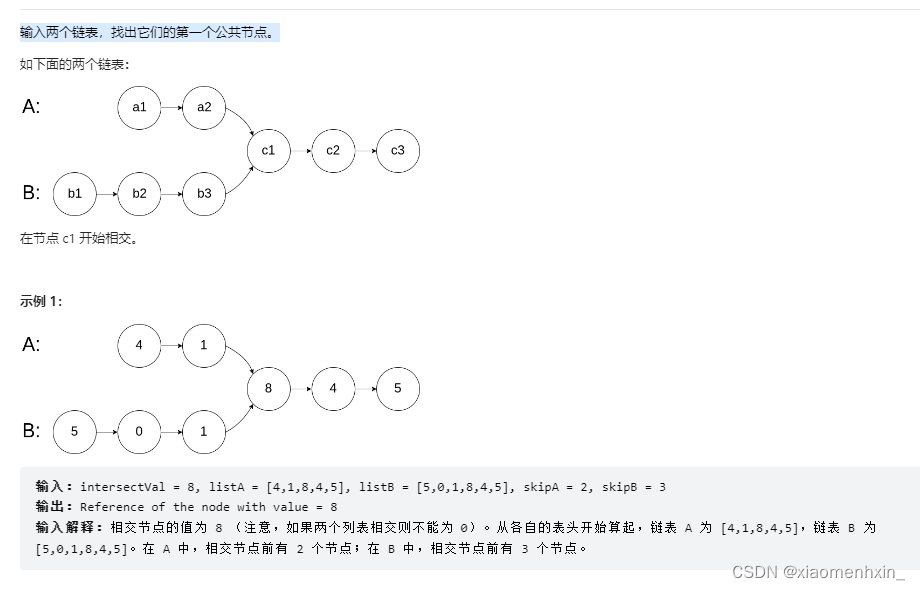
这道题目也很简单
使用双指针法就可以轻松解决
如下图
如果它们有交点
那么它们就会在交点处相遇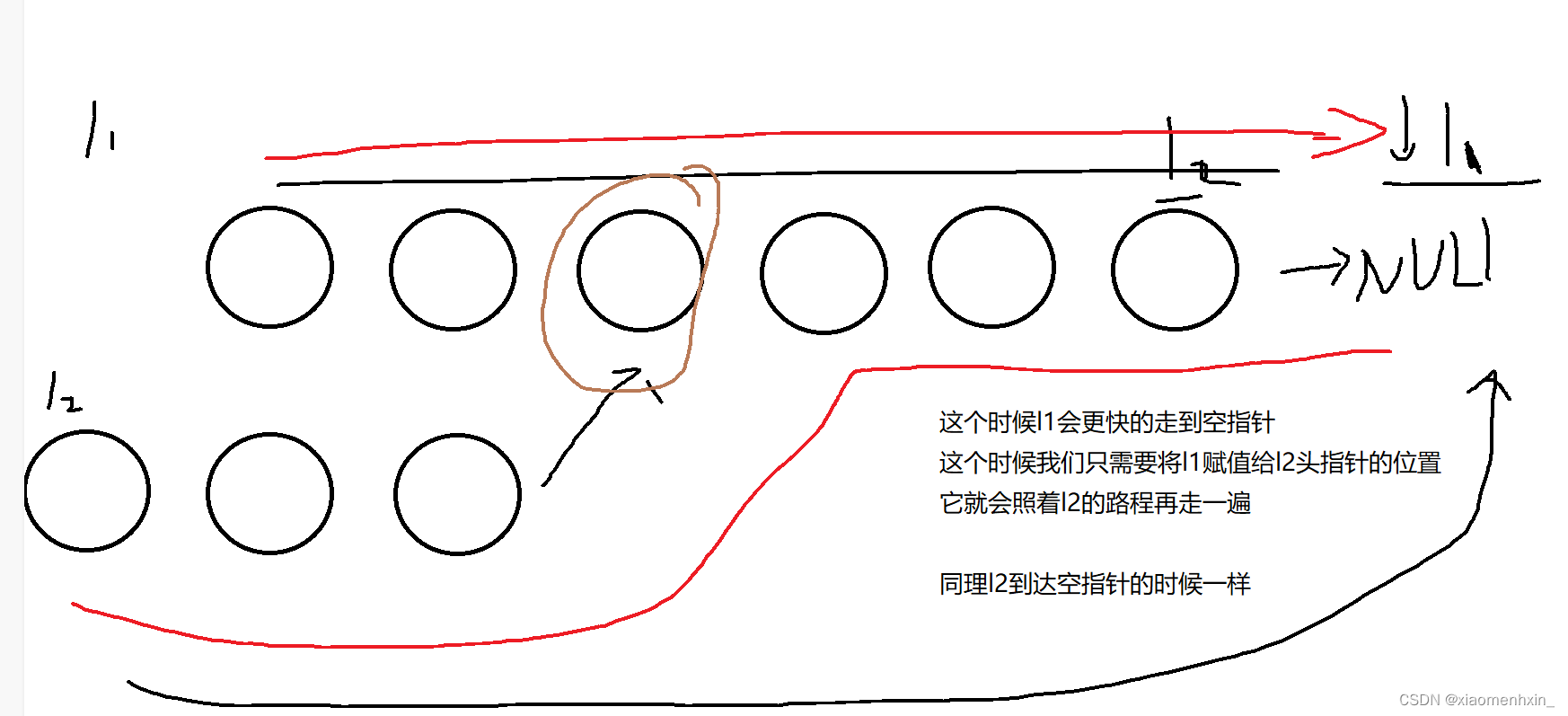
如果它们没有交点
那么它们就会在空指针处相遇
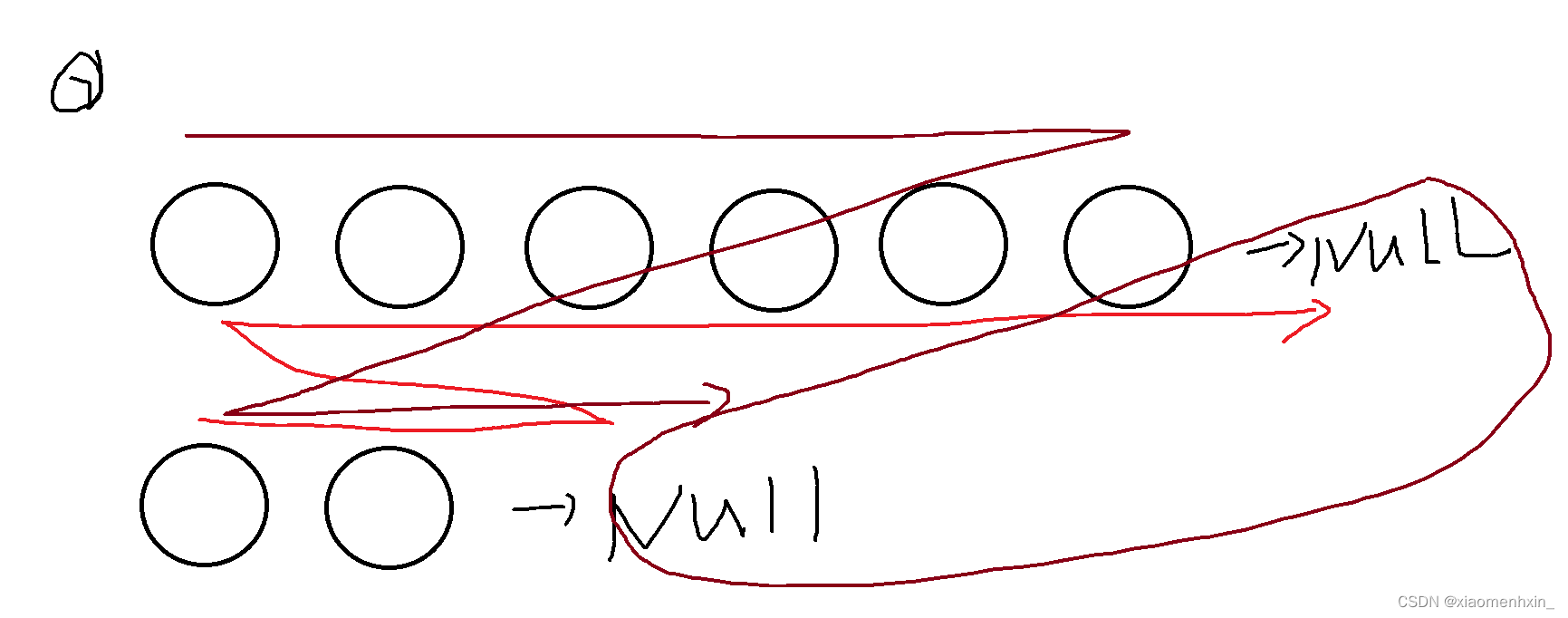
代码表示如下
structListNode*getIntersectionNode(structListNode*headA,structListNode*headB){if(headA==NULL){returnNULL;}if(headB==NULL){returnNULL;}structListNode*l1 =headA;structListNode*l2 =headB;while(l1!=l2){
l1=l1==NULL?headB:l1->next;
l2=l2==NULL?headA:l2->next;}return l2;}
编号0014 环形链表
给你一个链表的头节点 head ,判断链表中是否有环。
如果链表中有某个节点,可以通过连续跟踪 next 指针再次到达,则链表中存在环。 为了表示给定链表中的环,评测系统内部使用整数 pos 来表示链表尾连接到链表中的位置(索引从 0 开始)。注意:pos 不作为参数进行传递 。仅仅是为了标识链表的实际情况。
如果链表中存在环 ,则返回 true 。 否则,返回 false 。
来源:力扣(LeetCode)
链接:https://leetcode.cn/problems/linked-list-cycle
还是先上图

我们先来看有环的情况
这个时候实际上fast和slow会在里面陷入死循环
我们把这个图再抽象下
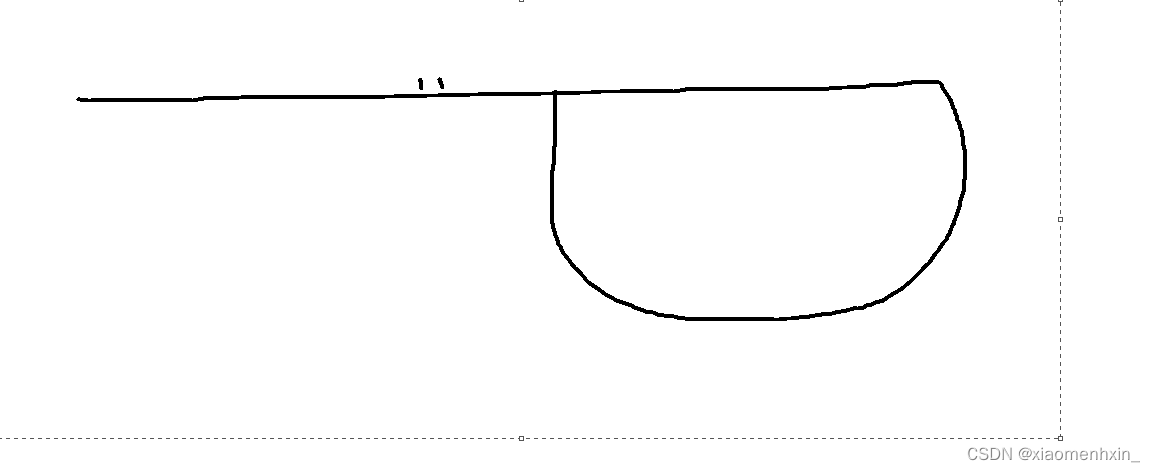
实际上就是一个这样子的图形
大家有没有表示眼熟?
这不就是我们的操场吗
那么我们把问题变一下
两个人跑步 一个跑的比较快 一个跑的比较慢
如果在一个直线的操场上它们会相遇嘛?
显然不会
但是如果在一个环形的操场上呢?
那必然会啊
那么我们接着来看

所以说这里就论证了当fast=2 slow=1时
它们在某个节点相遇的必然性
所以这个时候我们就可以上手写代码了
代码表示如下
bool hasCycle(structListNode*head){if(head==NULL|| head->next ==NULL){returnNULL;}structListNode* fast = head->next;structListNode* slow = head;while(fast!=NULL&& fast->next!=NULL){if(slow==fast){return true;}else{
slow = slow->next;
fast = fast->next->next;}}return false;}
编号0015 环形链表二
给定一个链表的头节点 head ,返回链表开始入环的第一个节点。 如果链表无环,则返回 null。
如果链表中有某个节点,可以通过连续跟踪 next 指针再次到达,则链表中存在环。 为了表示给定链表中的环,评测系统内部使用整数 pos 来表示链表尾连接到链表中的位置(索引从 0 开始)。如果 pos 是 -1,则在该链表中没有环。注意:pos 不作为参数进行传递,仅仅是为了标识链表的实际情况。
不允许修改 链表。
来源:力扣(LeetCode)
链接:https://leetcode.cn/problems/linked-list-cycle-ii
这一题跟上一题一样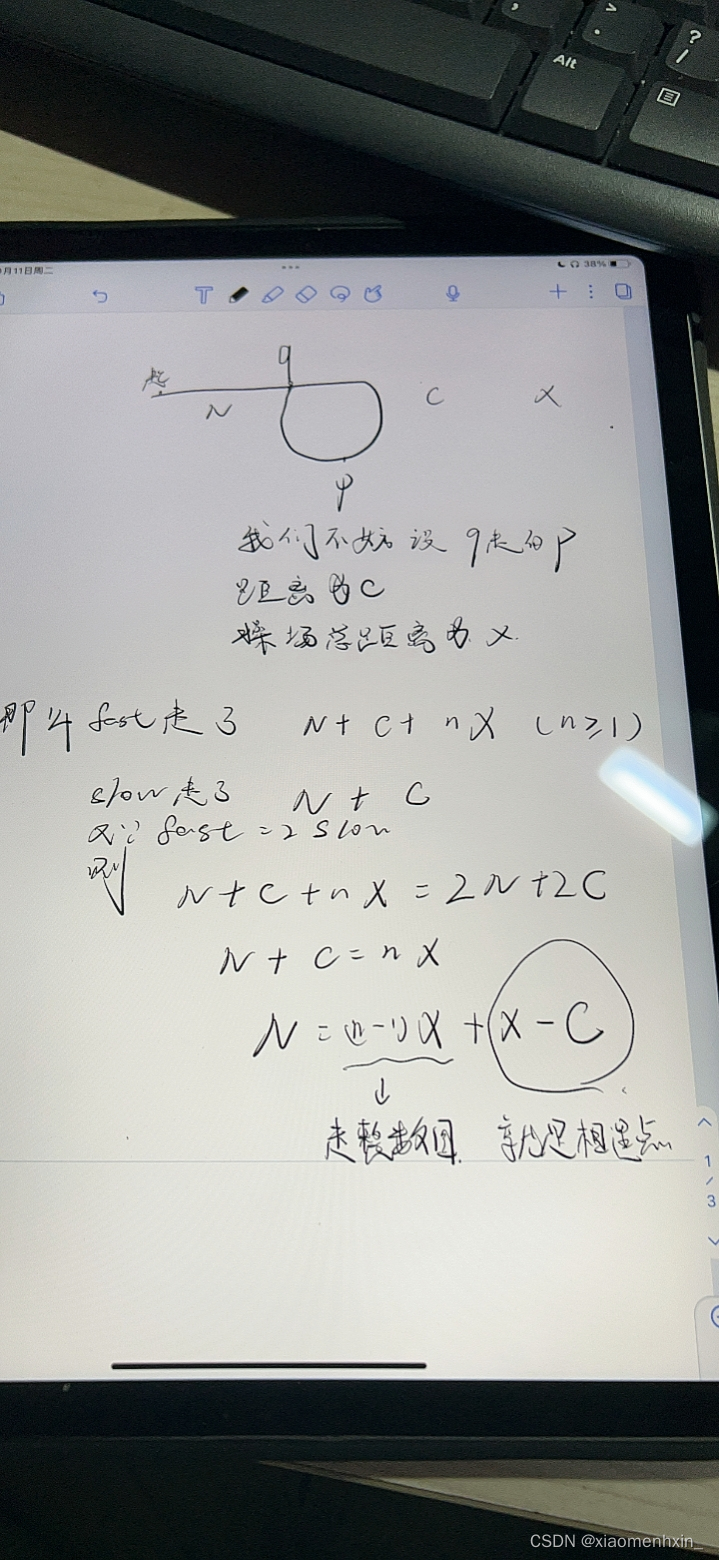
这样子就证明了
一个slow指针从起点开始走
一个slow指针从遇见的点开始走
它们会在环的起点相遇
代码表示如下
structListNode*detectCycle(structListNode*head){if(head==NULL|| head->next==NULL){returnNULL;}structListNode*slow =head;structListNode*fast =head;structListNode*cur =head;structListNode*pos =NULL;structListNode*meet =NULL;while(fast!=NULL&&fast->next!=NULL){
slow=slow->next;
fast=fast->next->next;if(fast==slow){
meet = fast;while(meet!=cur){
cur=cur->next;
meet=meet->next;}
pos = meet;return pos;}}returnNULL;}
版权归原作者 xiaomenhxin_ 所有, 如有侵权,请联系我们删除。